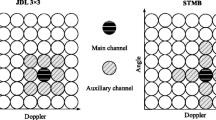Abstract
In general, space–time adaptive processing (STAP) can achieve excellent clutter suppression and moving target detection performance in the airborne multiple-input multiple-output (MIMO) radar for the increasing system degrees of freedom. However, the performance improvement is accompanied by the dramatic increase in computational cost and training sample demanding. Though reduced-dimensional STAP can alleviate these problems, its performance will still be heavily degraded for insufficient training sample support, which will frequently be met in the airborne MIMO radar. Hence, in this work, by utilizing the special structure of the MIMO radar signal, the STAP filter coefficients of the conventional joint domain localized processing method are constrained as the Kronecker product form so that the computational cost and training sample demanding are further reduced. Then, the tri-iterative algorithm is applied to find the desired solution. Simulation results demonstrate the effectiveness of the proposed method.





Similar content being viewed by others
References
D.W. Bliss, K.W, Forsythe, Multiple-input multiple-output (MIMO) radar and imaging: degrees of freedom and resolution, in Proceedings of 37th IEEE Asilomar Conference on Signal, Systems, Computers (2003), pp. 54–49
C.Y. Chen, P.P. Vaidyanathan, MIMO radar space–time adaptive processing using prolate spheroidal wave functions. IEEE Trans. Signal Process. 56(2), 623–635 (2007)
D. Feng, X.M. Li, H. Lv, Two-sided minimum-variance distortionless response beamformer for MIMO radar. Signal Process. 89(3), 328–332 (2009)
D. Feng, W. Zheng, A. Cichocki, Matrix-group algorithm via improved whitening process for extracting statistically independent sources from array signals. IEEE Trans. Signal Process. 55(3), 962–977 (2007)
E. Fisher, A. Haimovich, R. Blum, et al, MIMO radar: an idea whose time has come, in Proceeding of IEEE Radar Conference (2004), pp. 71–78
Y.Z. Fan, C.Y. Tsui, Low-COmplexity rotated QAM demapper for the iterative receiver targeting DVB-T2 standard, in IEEE Vehicular Technology Conference (2012), pp. 1–5
Y.Z. Fan, C.Y. Tsui, Low-latency MAP demapper architecture for coded modulation with iterative decoding, in IEEE International Symposium on Circuits and Systems (2014), pp. 730–733
J.R. Guerci, Space–Time Adaptive Processing for Radar (Artech House, Norwood, 2003)
Y. Guo, Y. Zhang, N. Tong, J. Gong, Angle estimation and self-calibration method for bistatic MIMO radar with transmit and receive array errors. Circuits Syst. Signal Process. 36(4), 1514–1534 (2017)
J. Liu, S. Zhou, W. Liu, J. Zheng, H. Liu, J. Li, Tunable adaptive detection in colocated MIMO radar. IEEE Trans. Signal Process. 66(4), 1080–1092 (2018)
N. Li, G. Cui, L. Kong, X. Yang, MIMO radar moving target detection against compound-Gaussian clutter. Circuits Syst. Signal Process. 33(6), 1819–1839 (2014)
W. Liu, Y. Wang, J. Liu, W. Xie, H. Chen, W. Gu, Adaptive detection without training data in colocated MIMO radar. IEEE Trans. Aerosp. Electron. Syst. 51(3), 2469–2479 (2015)
I.S. Reed, J.D. Mallett, L.E. Brennan, Rapid convergence rate in adaptive arrays. IEEE Trans. Aerosp. Electron. Syst. 10(6), 853–863 (1974)
P. Stoica, Y. Selen, Cyclic minimizers, majorization techniques, and the expectation-maximization algorithm: a refresher. IEEE Signal Process. Mag. 21(1), 112–114 (2004)
B. Tang, J. Li, Y. Zhang, J. Tang, Design of MIMO radar waveform covariance matrix for clutter and jamming suppression based on space time adaptive processing. Signal Process. 121, 60–69 (2016)
H. Wang, L. Cai, On adaptive spatial–temporal processing for airborne surveillance radar systems. IEEE Trans. Aerosp. Electron. Syst. 30(3), 660–670 (1994)
C. Wen, J. Peng, Y. Zhou, J. Wu, Enhanced three-dimensional joint domain localized STAP for airborne FDA-MIMO radar under dense false-target jamming scenario. IEEE Sensors J. 18(10), 4154–4166 (2018)
J.W. Xu, G.S. Liao, Y. Zhang, H. Ji, L. Huang, An adaptive range-angle-Doppler processing approach for FDA-MIMO radar using three-dimensional localization. IEEE J. Sel. Top. Signal Process. 11(2), 309–319 (2017)
L. Yang, L. Zhao, G. Bi, L. Zhang, SAR ground moving target imaging algorithm based on parametric and dynamic sparse Bayesian learning. IEEE Trans. Geosci. Remote Sens. 54(4), 2254–2267 (2016)
Z.C. Yang, Y.L. Qin, R.C. Lamare, H. Wang, X. Li, Sparsity-based direct data domain space–time adaptive processing with intrinsic clutter motion. Circuits Syst. Signal Process. 36(1), 1–28 (2017)
Y. Zhou, L. Wang, X. Chen, C. Wen, B. Jiang, D. Fang, An improving EFA for clutter suppression by using the persymmetric covariance matrix estimation. Circuits Syst. Signal Process. 37(2), 1–14 (2018)
Y. Zhou, D. Feng, G. Zhu, W. Nie, The post-Doppler adaptive processing method based on the spatial domain reconstruction. Signal Process. 111, 89–93 (2015)
Acknowledgements
This work was sponsored in part by National Natural Science Foundation of China under Grants 61503300, 41601353 and 61801383; the Scientific Research Plan of Education Department of Shaanxi Province under Grant 17JK0789.
Author information
Authors and Affiliations
Corresponding author
Rights and permissions
About this article
Cite this article
Zhou, Y., Wang, L., Li, Y. et al. A Fast Iterative Three-Dimensional Joint Domain Localized Method in Airborne MIMO Radar. Circuits Syst Signal Process 38, 3370–3383 (2019). https://doi.org/10.1007/s00034-018-1016-0
Received:
Revised:
Accepted:
Published:
Issue Date:
DOI: https://doi.org/10.1007/s00034-018-1016-0




